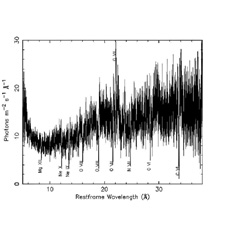February 17, 2000
CXC PR: 00-07
An international team of astronomers has used NASA's Chandra X-ray Observatory to make an energy bar code of hot gas in the vicinity of a giant black hole. These measurements, the most precise of their kind ever made with an X-ray telescope, demonstrate the existence of a blanket of warm gas that is expanding rapidly away from the black hole.
The team consists of Jelle Kaastra, Rolf Mewe and Albert Brinkman of Space Research Organization Netherlands (SRON) in Utrecht, Duane Liedahl of Lawrence Livermore National Laboratory in Livermore, Calif., and Stefanie Komossa of Max Planck Institute in Garching, Germany. A report of their findings will be published in the March issue of the European journal Astronomy & Astrophysics.
Kaastra and colleagues used the Low Energy Transmission Grating in conjunction with the High Resolution Camera to measure the number of X rays present at each energy. With this information they constructed an X-ray spectrum of the source.
Their target was the central region, or nucleus of the galaxy NGC 5548, which they observed for 24 hours. This galaxy is one of a class of galaxies known to have unusually bright nuclei that are associated with gas flowing around and into giant black holes. This inflow produces an enormous outpouring of energy that blows some of the matter away from the black hole.
Astronomers have used optical, ultraviolet, and X-ray telescopes in an effort to disentangle the complex nature of inflowing and outflowing gas at different distances from the black hole in NGC 5548. X-ray observations provide a ringside seat to the action around the black hole. By using the Low Energy Transmission Grating, the Dutch-US-German team concentrated on gas that forms a warm blanket that partially covers the innermost region where the highest energy X-rays are produced.
As the high-energy X rays stream away from the vicinity of the black hole, they heat the blanketing gas to temperatures of a few million degrees, and the blanket absorbs some of the X rays from the central source. This produces dark stripes, or absorption lines in the X-ray spectrum. Bright stripes or emission lines due to emission from the blanketing gas are also present. Since each element has its own unique structure, these lines can be read like a cosmic bar code to take inventory of the gas. The team was able to determine what atoms the gas contains and how many, the number of electrons each atom has retained in the hostile environment of the black hole, and how the gas is moving there. They found lines from eight different elements including carbon, nitrogen, oxygen, and iron. The amount of this gas was found to be about 100 times greater than that found with optical and ultraviolet observations.
The Low Energy Transmission Grating was built by the SRON. and the Max Planck Institute under the direction of Albert Brinkman. The High Resolution Camera was built by the Smithsonian Astrophysical Observatory in Cambridge, Mass. under the direction of Stephen Murray.
To follow Chandra's progress or download images visit the Chandra sites at:
NASA's Marshall Space Flight Center in Huntsville, Ala., manages the Chandra program. TRW, Inc., Redondo Beach, Calif., is the prime contractor for the spacecraft. The Smithsonian's Chandra X-ray Center controls science and flight operations from Cambridge, Mass.
High resolution digital versions of the X-ray spectrum (JPG, 300 dpi TIFF ) and other information associated with this release are available on the Internet at:
MEDIA CONTACTS
Steve Roy
Marshall Space Flight Center, Huntsville, AL
Phone: 256-544-6535
http://www.nasa.gov/centers/marshall/news
Dr. Wallace Tucker
Chandra X-ray Observatory Center
Harvard-Smithsonian Center for Astrophysics, Cambridge, MA
Phone: 617-496-7998



